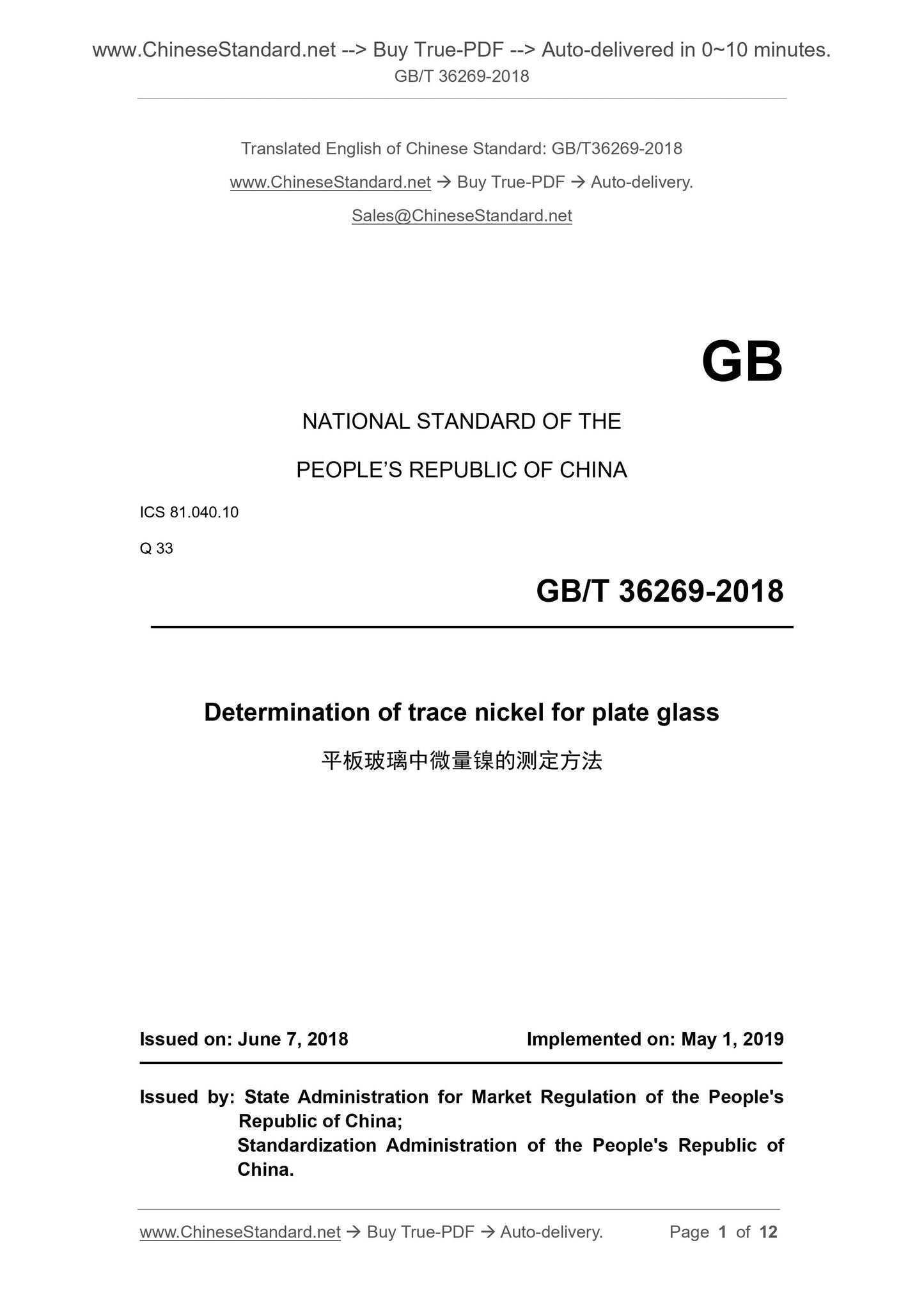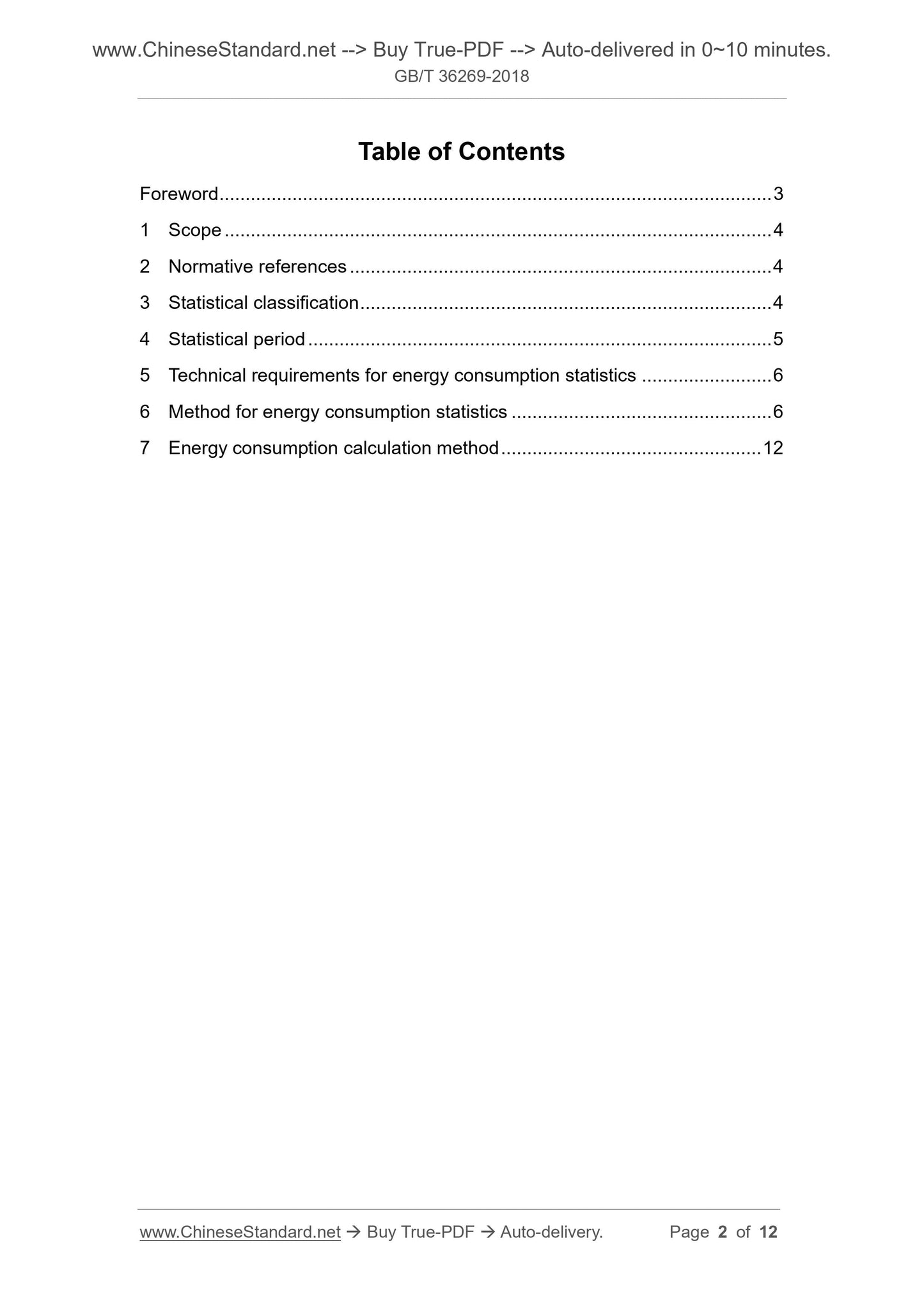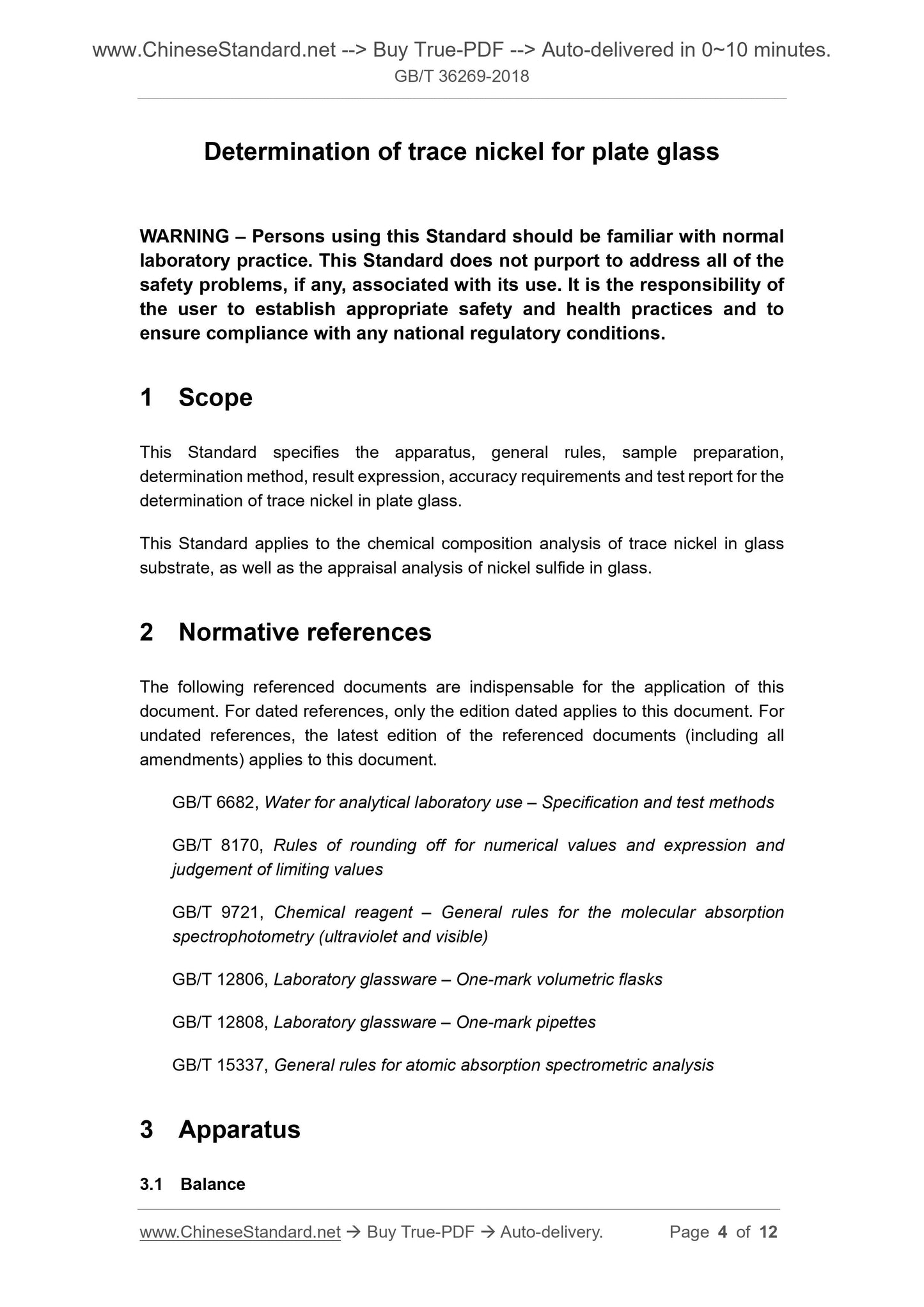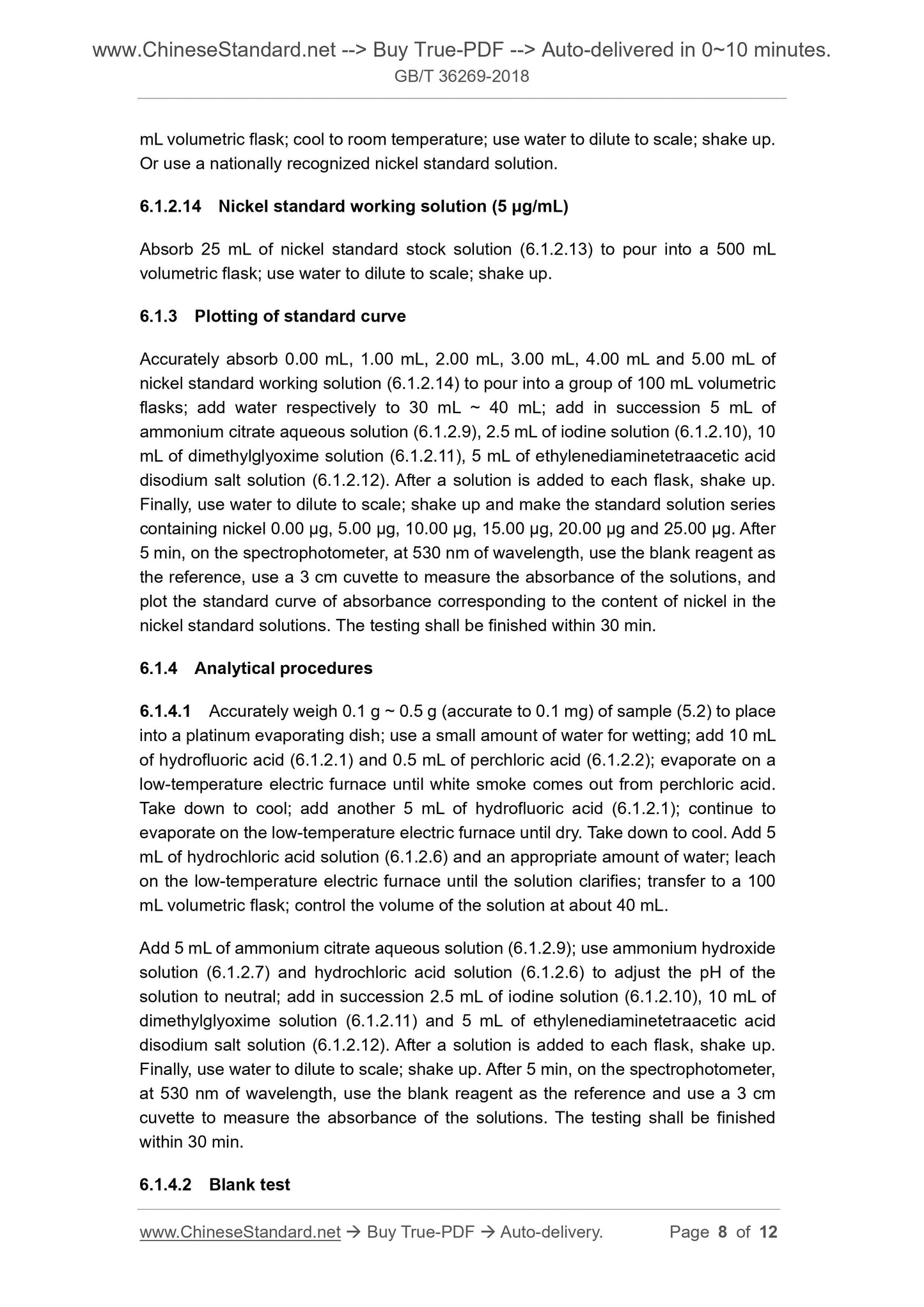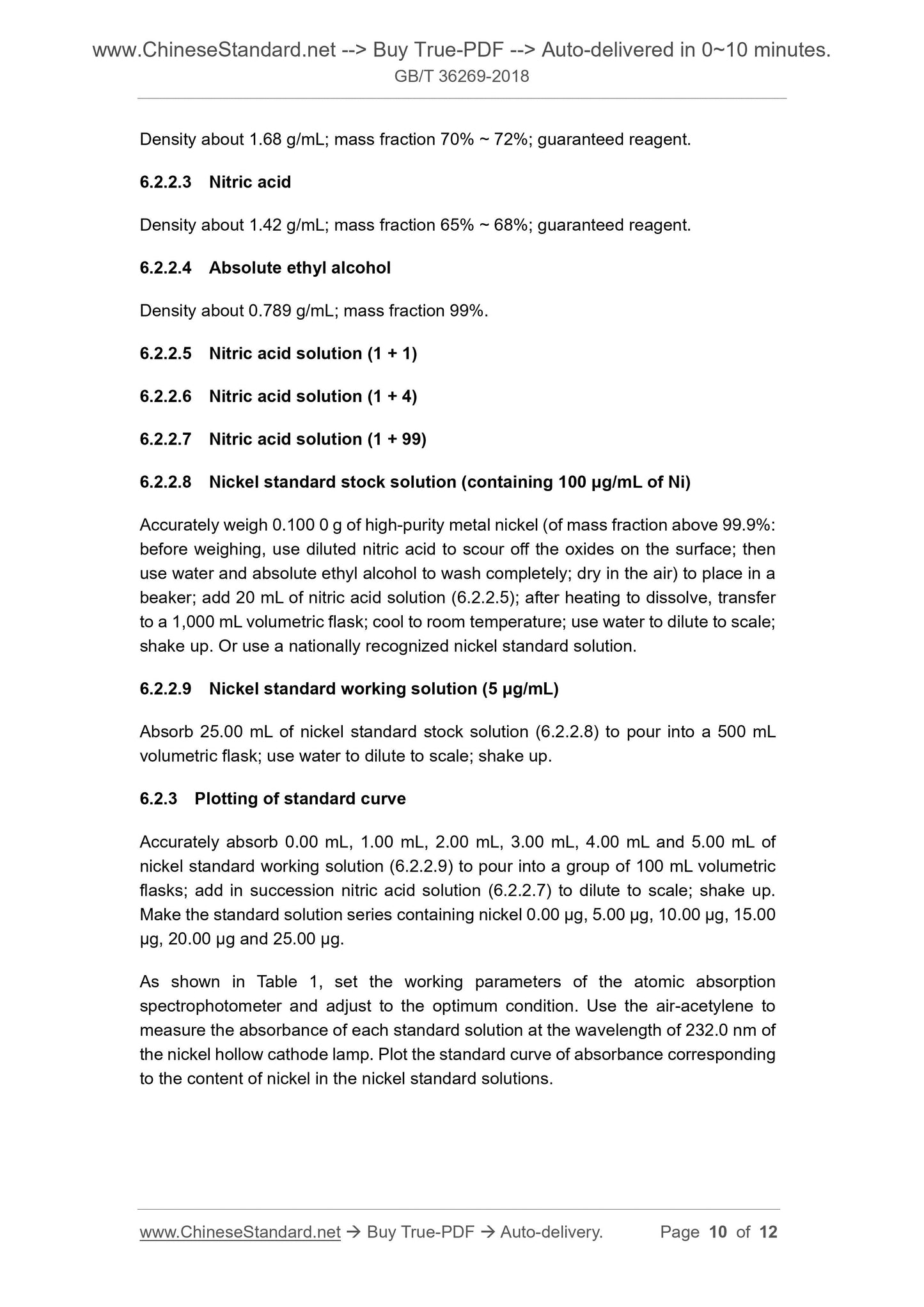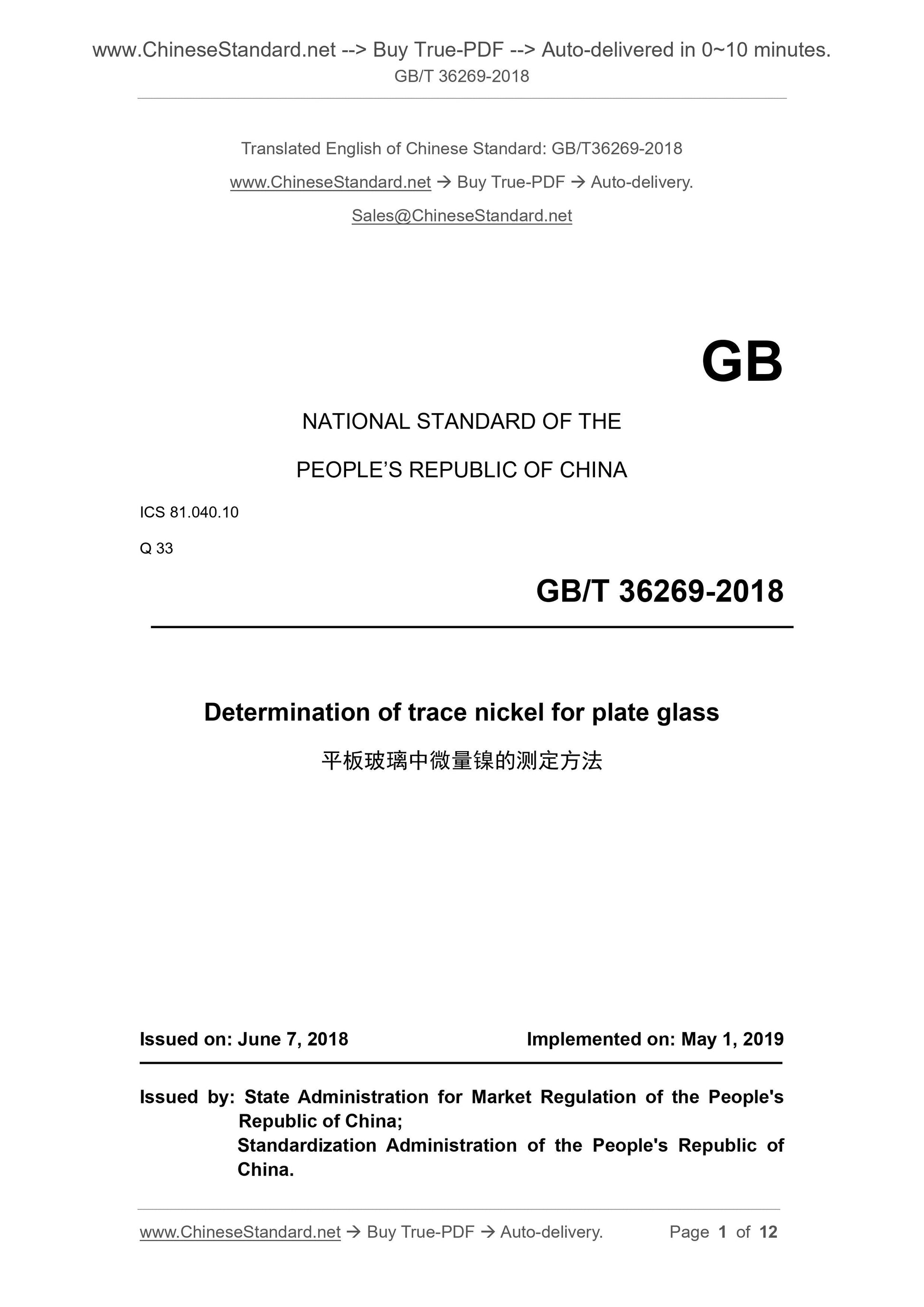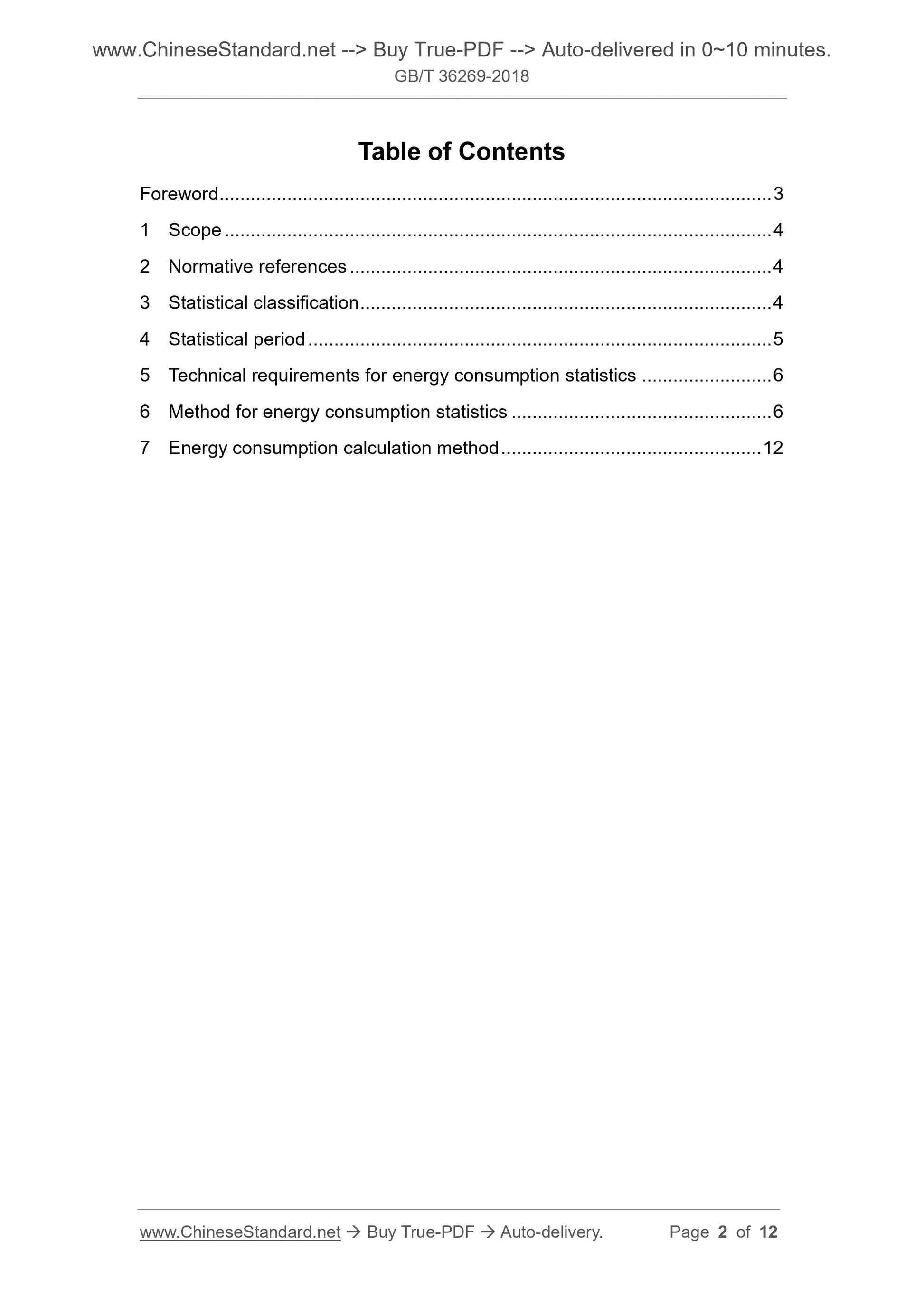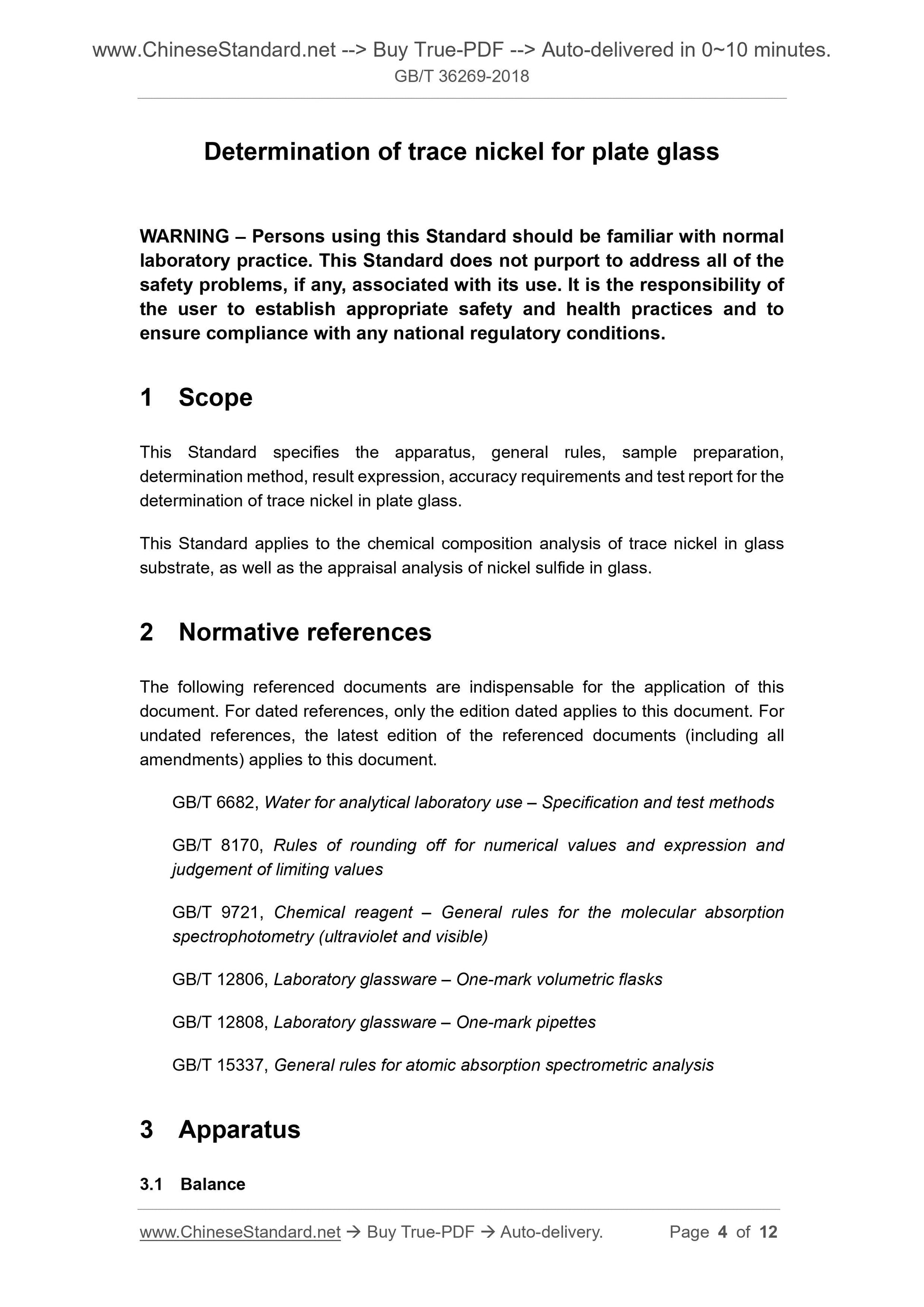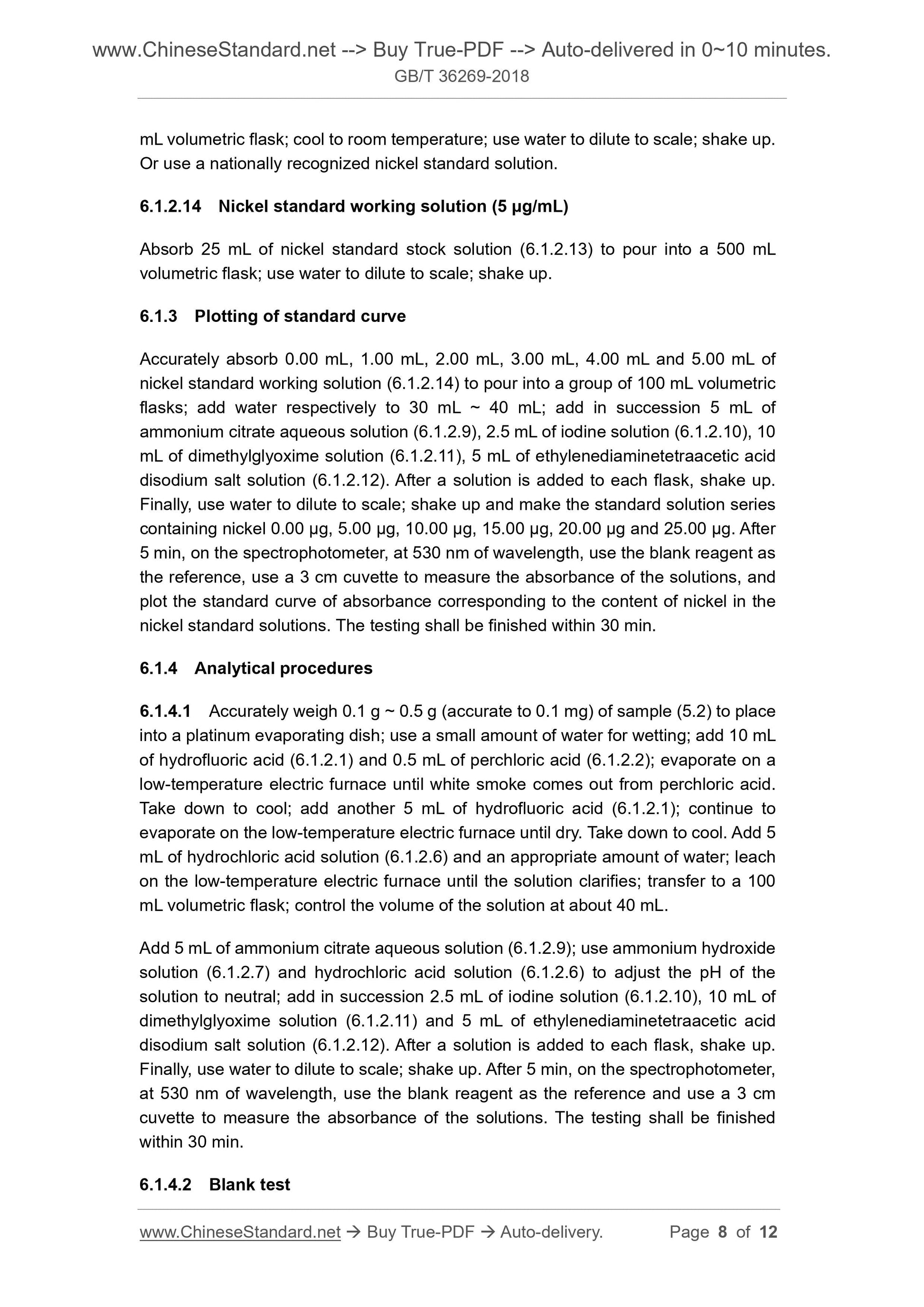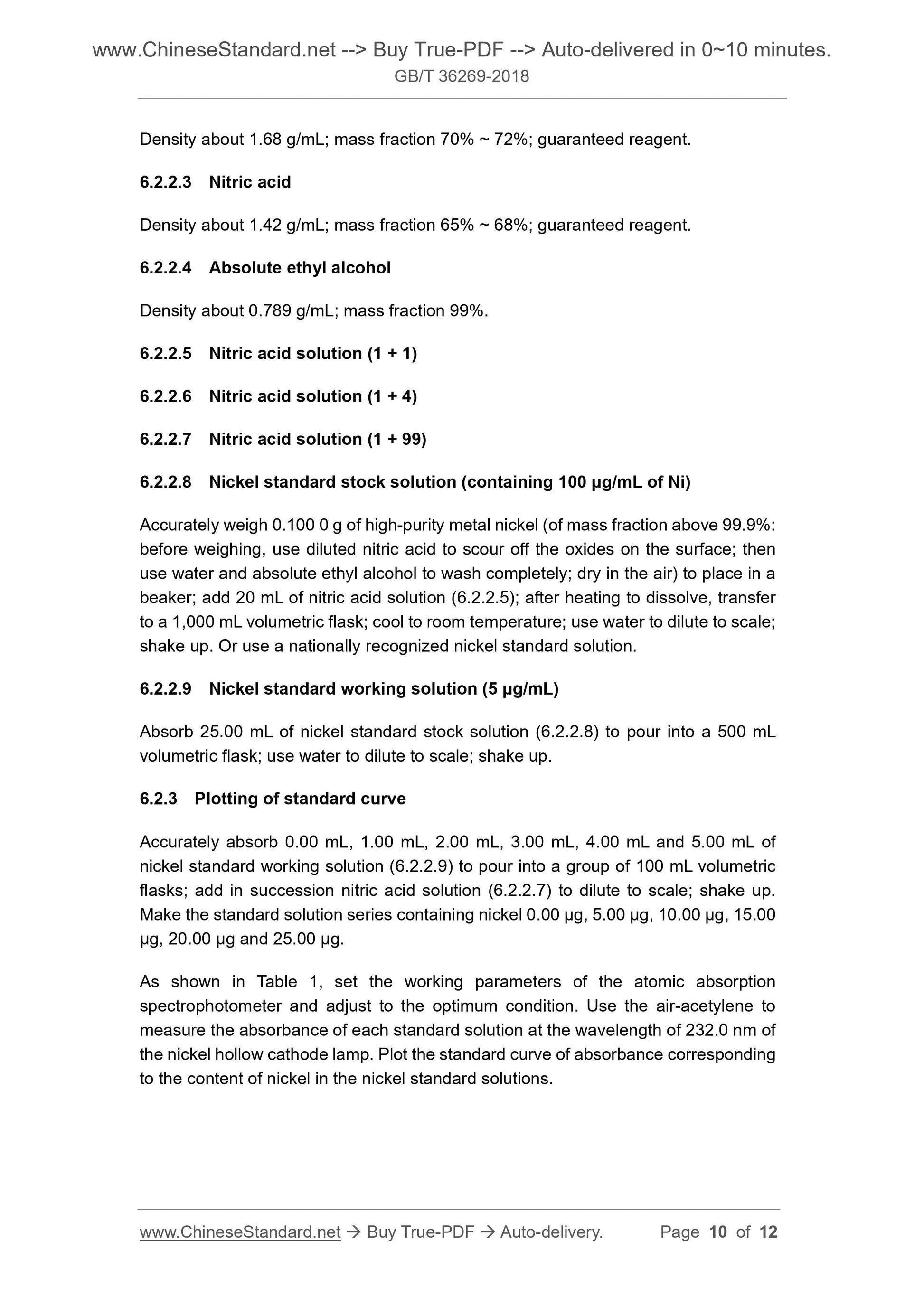1
/
of
5
www.ChineseStandard.us -- Field Test Asia Pte. Ltd.
GB/T 36269-2018 English PDF (GB/T36269-2018)
GB/T 36269-2018 English PDF (GB/T36269-2018)
Regular price
$150.00
Regular price
Sale price
$150.00
Unit price
/
per
Shipping calculated at checkout.
Couldn't load pickup availability
GB/T 36269-2018: Determination of trace nickel for plate glass
Delivery: 9 seconds. Download (& Email) true-PDF + Invoice.
Get Quotation: Click GB/T 36269-2018 (Self-service in 1-minute)
Historical versions (Master-website): GB/T 36269-2018
Preview True-PDF (Reload/Scroll-down if blank)
GB/T 36269-2018
GB
NATIONAL STANDARD OF THE
PEOPLE’S REPUBLIC OF CHINA
ICS 81.040.10
Q 33
Determination of trace nickel for plate glass
ISSUED ON. JUNE 7, 2018
IMPLEMENTED ON. MAY 1, 2019
Issued by. State Administration for Market Regulation of the People's
Republic of China;
Standardization Administration of the People's Republic of
China.
Table of Contents
Foreword ... 3
1 Scope ... 4
2 Normative references ... 4
3 Statistical classification ... 4
4 Statistical period ... 5
5 Technical requirements for energy consumption statistics ... 6
6 Method for energy consumption statistics ... 6
7 Energy consumption calculation method ... 12
Determination of trace nickel for plate glass
WARNING – Persons using this Standard should be familiar with normal
laboratory practice. This Standard does not purport to address all of the
safety problems, if any, associated with its use. It is the responsibility of
the user to establish appropriate safety and health practices and to
ensure compliance with any national regulatory conditions.
1 Scope
This Standard specifies the apparatus, general rules, sample preparation,
determination method, result expression, accuracy requirements and test report for the
determination of trace nickel in plate glass.
This Standard applies to the chemical composition analysis of trace nickel in glass
substrate, as well as the appraisal analysis of nickel sulfide in glass.
2 Normative references
The following referenced documents are indispensable for the application of this
document. For dated references, only the edition dated applies to this document. For
undated references, the latest edition of the referenced documents (including all
amendments) applies to this document.
GB/T 6682, Water for analytical laboratory use – Specification and test methods
GB/T 8170, Rules of rounding off for numerical values and expression and
judgement of limiting values
GB/T 9721, Chemical reagent – General rules for the molecular absorption
spectrophotometry (ultraviolet and visible)
GB/T 12806, Laboratory glassware – One-mark volumetric flasks
GB/T 12808, Laboratory glassware – One-mark pipettes
GB/T 15337, General rules for atomic absorption spectrometric analysis
3 Apparatus
3.1 Balance
mL volumetric flask; cool to room temperature; use water to dilute to scale; shake up.
Or use a nationally recognized nickel standard solution.
6.1.2.14 Nickel standard working solution (5 μg/mL)
Absorb 25 mL of nickel standard stock solution (6.1.2.13) to pour into a 500 mL
volumetric flask; use water to dilute to scale; shake up.
6.1.3 Plotting of standard curve
Accurately absorb 0.00 mL, 1.00 mL, 2.00 mL, 3.00 mL, 4.00 mL and 5.00 mL of
nickel standard working solution (6.1.2.14) to pour into a group of 100 mL volumetric
flasks; add water respectively to 30 mL ~ 40 mL; add in succession 5 mL of
ammonium citrate aqueous solution (6.1.2.9), 2.5 mL of iodine solution (6.1.2.10), 10
mL of dimethylglyoxime solution (6.1.2.11), 5 mL of ethylenediaminetetraacetic acid
disodium salt solution (6.1.2.12). After a solution is added to each flask, shake up.
Finally, use water to dilute to scale; shake up and make the standard solution series
containing nickel 0.00 μg, 5.00 μg, 10.00 μg, 15.00 μg, 20.00 μg and 25.00 μg. After
5 min, on the spectrophotometer, at 530 nm of wavelength, use the blank reagent as
the reference, use a 3 cm cuvette to measure the absorbance of the solutions, and
plot the standard curve of absorbance corresponding to the content of nickel in the
nickel standard solutions. The testing shall be finished within 30 min.
6.1.4 Analytical procedures
6.1.4.1 Accurately weigh 0.1 g ~ 0.5 g (accurate to 0.1 mg) of sample (5.2) to place
into a platinum evaporating dish; use a small amount of water for wetting; add 10 mL
of hydrofluoric acid (6.1.2.1) and 0.5 mL of perchloric acid (6.1.2.2); evaporate on a
low-temperature electric furnace until white smoke comes out from perchloric acid.
Take down to cool; add another 5 mL of hydrofluoric acid (6.1.2.1); continue to
evaporate on the low-temperature electric furnace until dry. Take down to cool. Add 5
mL of hydrochloric acid solution (6.1.2.6) and an appropriate amount of water; leach
on the low-temperature electric furnace until the solution clarifies; transfer to a 100
mL volumetric flask; control the volume of the solution at about 40 mL.
Add 5 mL of ammonium citrate aqueous solution (6.1.2.9); use ammonium hydroxide
solution (6.1.2.7) and hydrochloric acid solution (6.1.2.6) to adjust the pH of the
solution to neutral; add in succession 2.5 mL of iodine solution (6.1.2.10), 10 mL of
dimethylglyoxime solution (6.1.2.11) and 5 mL of ethylenediaminetetraacetic acid
disodium salt solution (6.1.2.12). After a solution is added to each flask, shake up.
Finally, use water to dilute to scale; shake up. After 5 min, on the spectrophotometer,
at 530 nm of wavelength, use the blank reagent as the reference and use a 3 cm
cuvette to measure the absorbance of the solutions. The testing shall be finished
within 30 min.
6.1.4.2 Blank test
Density about 1.68 g/mL; mass fraction 70% ~ 72%; guaranteed reagent.
6.2.2.3 Nitric acid
Density about 1.42 g/mL; mass fraction 65% ~ 68%; guaranteed reagent.
6.2.2.4 Absolute ethyl alcohol
Density about 0.789 g/mL; mass fraction 99%.
6.2.2.5 Nitric acid solution (1 + 1)
6.2.2.6 Nitric acid solution (1 + 4)
6.2.2.7 Nitric acid solution (1 + 99)
6.2.2.8 Nickel standard stock solution (containing 100 μg/mL of Ni)
Accurately weigh 0.100 0 g of high-purity metal nickel (of mass fraction above 99.9%.
before weighing, use diluted nitric acid to scour off the oxides on the surface; then
use water and absolute ethyl alcohol to wash completely; dry in the air) to place in a
beaker; add 20 mL of nitric acid solution (6.2.2.5); after heating to dissolve, transfer
to a 1,000 mL volumetric flask; cool to room temperature; use water to dilute to scale;
shake up. Or use a nationally recognized nickel standard solution.
6.2.2.9 Nickel standard working solution (5 μg/mL)
Absorb 25.00 mL of nickel standard stock solution (6.2.2.8) to pour into a 500 mL
volumetric flask; use water to dilute to scale; shake up.
6.2.3 Plotting of standard curve
Accurately absorb 0.00 mL, 1.00 mL, 2.00 mL, 3.00 mL, 4.00 mL and 5.00 mL of
nickel standard working solution (6.2.2.9) to pour into a group of 100 mL volumetric
flasks; add in succession nitric acid solution (6.2.2.7) to dilute to scale; shake up.
Make the standard solution series containing nickel 0.00 μg, 5.00 μg, 10.00 μg, 15.00
μg, 20.00 μg and 25.00 μg.
As shown in Table 1, set the working parameters of the atomic absorption
spectrophotometer and adjust to the optimum condition. Use the air-acetylene to
measure the absorbance of each standard solution at the wavelength of 232.0 nm of
the nickel hollow cathode lamp. Plot the standard curve of absorbance corresponding
to the content of nickel in the nickel standard solutions.
GB/T 36269-2018
GB
NATIONAL STANDARD OF THE
PEOPLE’S REPUBLIC OF CHINA
ICS 81.040.10
Q 33
Determination of trace nickel for plate glass
ISSUED ON. JUNE 7, 2018
IMPLEMENTED ON. MAY 1, 2019
Issued by. State Administration for Market Regulation of the People's
Republic of China;
Standardization Administration of the People's Republic of
China.
Table of Contents
Foreword ... 3
1 Scope ... 4
2 Normative references ... 4
3 Statistical classification ... 4
4 Statistical period ... 5
5 Technical requirements for energy consumption statistics ... 6
6 Method for energy consumption statistics ... 6
7 Energy consumption calculation method ... 12
Determination of trace nickel for plate glass
WARNING – Persons using this Standard should be familiar with normal
laboratory practice. This Standard does not purport to address all of the
safety problems, if any, associated with its use. It is the responsibility of
the user to establish appropriate safety and health practices and to
ensure compliance with any national regulatory conditions.
1 Scope
This Standard specifies the apparatus, general rules, sample preparation,
determination method, result expression, accuracy requirements and test report for the
determination of trace nickel in plate glass.
This Standard applies to the chemical composition analysis of trace nickel in glass
substrate, as well as the appraisal analysis of nickel sulfide in glass.
2 Normative references
The following referenced documents are indispensable for the application of this
document. For dated references, only the edition dated applies to this document. For
undated references, the latest edition of the referenced documents (including all
amendments) applies to this document.
GB/T 6682, Water for analytical laboratory use – Specification and test methods
GB/T 8170, Rules of rounding off for numerical values and expression and
judgement of limiting values
GB/T 9721, Chemical reagent – General rules for the molecular absorption
spectrophotometry (ultraviolet and visible)
GB/T 12806, Laboratory glassware – One-mark volumetric flasks
GB/T 12808, Laboratory glassware – One-mark pipettes
GB/T 15337, General rules for atomic absorption spectrometric analysis
3 Apparatus
3.1 Balance
mL volumetric flask; cool to room temperature; use water to dilute to scale; shake up.
Or use a nationally recognized nickel standard solution.
6.1.2.14 Nickel standard working solution (5 μg/mL)
Absorb 25 mL of nickel standard stock solution (6.1.2.13) to pour into a 500 mL
volumetric flask; use water to dilute to scale; shake up.
6.1.3 Plotting of standard curve
Accurately absorb 0.00 mL, 1.00 mL, 2.00 mL, 3.00 mL, 4.00 mL and 5.00 mL of
nickel standard working solution (6.1.2.14) to pour into a group of 100 mL volumetric
flasks; add water respectively to 30 mL ~ 40 mL; add in succession 5 mL of
ammonium citrate aqueous solution (6.1.2.9), 2.5 mL of iodine solution (6.1.2.10), 10
mL of dimethylglyoxime solution (6.1.2.11), 5 mL of ethylenediaminetetraacetic acid
disodium salt solution (6.1.2.12). After a solution is added to each flask, shake up.
Finally, use water to dilute to scale; shake up and make the standard solution series
containing nickel 0.00 μg, 5.00 μg, 10.00 μg, 15.00 μg, 20.00 μg and 25.00 μg. After
5 min, on the spectrophotometer, at 530 nm of wavelength, use the blank reagent as
the reference, use a 3 cm cuvette to measure the absorbance of the solutions, and
plot the standard curve of absorbance corresponding to the content of nickel in the
nickel standard solutions. The testing shall be finished within 30 min.
6.1.4 Analytical procedures
6.1.4.1 Accurately weigh 0.1 g ~ 0.5 g (accurate to 0.1 mg) of sample (5.2) to place
into a platinum evaporating dish; use a small amount of water for wetting; add 10 mL
of hydrofluoric acid (6.1.2.1) and 0.5 mL of perchloric acid (6.1.2.2); evaporate on a
low-temperature electric furnace until white smoke comes out from perchloric acid.
Take down to cool; add another 5 mL of hydrofluoric acid (6.1.2.1); continue to
evaporate on the low-temperature electric furnace until dry. Take down to cool. Add 5
mL of hydrochloric acid solution (6.1.2.6) and an appropriate amount of water; leach
on the low-temperature electric furnace until the solution clarifies; transfer to a 100
mL volumetric flask; control the volume of the solution at about 40 mL.
Add 5 mL of ammonium citrate aqueous solution (6.1.2.9); use ammonium hydroxide
solution (6.1.2.7) and hydrochloric acid solution (6.1.2.6) to adjust the pH of the
solution to neutral; add in succession 2.5 mL of iodine solution (6.1.2.10), 10 mL of
dimethylglyoxime solution (6.1.2.11) and 5 mL of ethylenediaminetetraacetic acid
disodium salt solution (6.1.2.12). After a solution is added to each flask, shake up.
Finally, use water to dilute to scale; shake up. After 5 min, on the spectrophotometer,
at 530 nm of wavelength, use the blank reagent as the reference and use a 3 cm
cuvette to measure the absorbance of the solutions. The testing shall be finished
within 30 min.
6.1.4.2 Blank test
Density about 1.68 g/mL; mass fraction 70% ~ 72%; guaranteed reagent.
6.2.2.3 Nitric acid
Density about 1.42 g/mL; mass fraction 65% ~ 68%; guaranteed reagent.
6.2.2.4 Absolute ethyl alcohol
Density about 0.789 g/mL; mass fraction 99%.
6.2.2.5 Nitric acid solution (1 + 1)
6.2.2.6 Nitric acid solution (1 + 4)
6.2.2.7 Nitric acid solution (1 + 99)
6.2.2.8 Nickel standard stock solution (containing 100 μg/mL of Ni)
Accurately weigh 0.100 0 g of high-purity metal nickel (of mass fraction above 99.9%.
before weighing, use diluted nitric acid to scour off the oxides on the surface; then
use water and absolute ethyl alcohol to wash completely; dry in the air) to place in a
beaker; add 20 mL of nitric acid solution (6.2.2.5); after heating to dissolve, transfer
to a 1,000 mL volumetric flask; cool to room temperature; use water to dilute to scale;
shake up. Or use a nationally recognized nickel standard solution.
6.2.2.9 Nickel standard working solution (5 μg/mL)
Absorb 25.00 mL of nickel standard stock solution (6.2.2.8) to pour into a 500 mL
volumetric flask; use water to dilute to scale; shake up.
6.2.3 Plotting of standard curve
Accurately absorb 0.00 mL, 1.00 mL, 2.00 mL, 3.00 mL, 4.00 mL and 5.00 mL of
nickel standard working solution (6.2.2.9) to pour into a group of 100 mL volumetric
flasks; add in succession nitric acid solution (6.2.2.7) to dilute to scale; shake up.
Make the standard solution series containing nickel 0.00 μg, 5.00 μg, 10.00 μg, 15.00
μg, 20.00 μg and 25.00 μg.
As shown in Table 1, set the working parameters of the atomic absorption
spectrophotometer and adjust to the optimum condition. Use the air-acetylene to
measure the absorbance of each standard solution at the wavelength of 232.0 nm of
the nickel hollow cathode lamp. Plot the standard curve of absorbance corresponding
to the content of ni...
Delivery: 9 seconds. Download (& Email) true-PDF + Invoice.
Get Quotation: Click GB/T 36269-2018 (Self-service in 1-minute)
Historical versions (Master-website): GB/T 36269-2018
Preview True-PDF (Reload/Scroll-down if blank)
GB/T 36269-2018
GB
NATIONAL STANDARD OF THE
PEOPLE’S REPUBLIC OF CHINA
ICS 81.040.10
Q 33
Determination of trace nickel for plate glass
ISSUED ON. JUNE 7, 2018
IMPLEMENTED ON. MAY 1, 2019
Issued by. State Administration for Market Regulation of the People's
Republic of China;
Standardization Administration of the People's Republic of
China.
Table of Contents
Foreword ... 3
1 Scope ... 4
2 Normative references ... 4
3 Statistical classification ... 4
4 Statistical period ... 5
5 Technical requirements for energy consumption statistics ... 6
6 Method for energy consumption statistics ... 6
7 Energy consumption calculation method ... 12
Determination of trace nickel for plate glass
WARNING – Persons using this Standard should be familiar with normal
laboratory practice. This Standard does not purport to address all of the
safety problems, if any, associated with its use. It is the responsibility of
the user to establish appropriate safety and health practices and to
ensure compliance with any national regulatory conditions.
1 Scope
This Standard specifies the apparatus, general rules, sample preparation,
determination method, result expression, accuracy requirements and test report for the
determination of trace nickel in plate glass.
This Standard applies to the chemical composition analysis of trace nickel in glass
substrate, as well as the appraisal analysis of nickel sulfide in glass.
2 Normative references
The following referenced documents are indispensable for the application of this
document. For dated references, only the edition dated applies to this document. For
undated references, the latest edition of the referenced documents (including all
amendments) applies to this document.
GB/T 6682, Water for analytical laboratory use – Specification and test methods
GB/T 8170, Rules of rounding off for numerical values and expression and
judgement of limiting values
GB/T 9721, Chemical reagent – General rules for the molecular absorption
spectrophotometry (ultraviolet and visible)
GB/T 12806, Laboratory glassware – One-mark volumetric flasks
GB/T 12808, Laboratory glassware – One-mark pipettes
GB/T 15337, General rules for atomic absorption spectrometric analysis
3 Apparatus
3.1 Balance
mL volumetric flask; cool to room temperature; use water to dilute to scale; shake up.
Or use a nationally recognized nickel standard solution.
6.1.2.14 Nickel standard working solution (5 μg/mL)
Absorb 25 mL of nickel standard stock solution (6.1.2.13) to pour into a 500 mL
volumetric flask; use water to dilute to scale; shake up.
6.1.3 Plotting of standard curve
Accurately absorb 0.00 mL, 1.00 mL, 2.00 mL, 3.00 mL, 4.00 mL and 5.00 mL of
nickel standard working solution (6.1.2.14) to pour into a group of 100 mL volumetric
flasks; add water respectively to 30 mL ~ 40 mL; add in succession 5 mL of
ammonium citrate aqueous solution (6.1.2.9), 2.5 mL of iodine solution (6.1.2.10), 10
mL of dimethylglyoxime solution (6.1.2.11), 5 mL of ethylenediaminetetraacetic acid
disodium salt solution (6.1.2.12). After a solution is added to each flask, shake up.
Finally, use water to dilute to scale; shake up and make the standard solution series
containing nickel 0.00 μg, 5.00 μg, 10.00 μg, 15.00 μg, 20.00 μg and 25.00 μg. After
5 min, on the spectrophotometer, at 530 nm of wavelength, use the blank reagent as
the reference, use a 3 cm cuvette to measure the absorbance of the solutions, and
plot the standard curve of absorbance corresponding to the content of nickel in the
nickel standard solutions. The testing shall be finished within 30 min.
6.1.4 Analytical procedures
6.1.4.1 Accurately weigh 0.1 g ~ 0.5 g (accurate to 0.1 mg) of sample (5.2) to place
into a platinum evaporating dish; use a small amount of water for wetting; add 10 mL
of hydrofluoric acid (6.1.2.1) and 0.5 mL of perchloric acid (6.1.2.2); evaporate on a
low-temperature electric furnace until white smoke comes out from perchloric acid.
Take down to cool; add another 5 mL of hydrofluoric acid (6.1.2.1); continue to
evaporate on the low-temperature electric furnace until dry. Take down to cool. Add 5
mL of hydrochloric acid solution (6.1.2.6) and an appropriate amount of water; leach
on the low-temperature electric furnace until the solution clarifies; transfer to a 100
mL volumetric flask; control the volume of the solution at about 40 mL.
Add 5 mL of ammonium citrate aqueous solution (6.1.2.9); use ammonium hydroxide
solution (6.1.2.7) and hydrochloric acid solution (6.1.2.6) to adjust the pH of the
solution to neutral; add in succession 2.5 mL of iodine solution (6.1.2.10), 10 mL of
dimethylglyoxime solution (6.1.2.11) and 5 mL of ethylenediaminetetraacetic acid
disodium salt solution (6.1.2.12). After a solution is added to each flask, shake up.
Finally, use water to dilute to scale; shake up. After 5 min, on the spectrophotometer,
at 530 nm of wavelength, use the blank reagent as the reference and use a 3 cm
cuvette to measure the absorbance of the solutions. The testing shall be finished
within 30 min.
6.1.4.2 Blank test
Density about 1.68 g/mL; mass fraction 70% ~ 72%; guaranteed reagent.
6.2.2.3 Nitric acid
Density about 1.42 g/mL; mass fraction 65% ~ 68%; guaranteed reagent.
6.2.2.4 Absolute ethyl alcohol
Density about 0.789 g/mL; mass fraction 99%.
6.2.2.5 Nitric acid solution (1 + 1)
6.2.2.6 Nitric acid solution (1 + 4)
6.2.2.7 Nitric acid solution (1 + 99)
6.2.2.8 Nickel standard stock solution (containing 100 μg/mL of Ni)
Accurately weigh 0.100 0 g of high-purity metal nickel (of mass fraction above 99.9%.
before weighing, use diluted nitric acid to scour off the oxides on the surface; then
use water and absolute ethyl alcohol to wash completely; dry in the air) to place in a
beaker; add 20 mL of nitric acid solution (6.2.2.5); after heating to dissolve, transfer
to a 1,000 mL volumetric flask; cool to room temperature; use water to dilute to scale;
shake up. Or use a nationally recognized nickel standard solution.
6.2.2.9 Nickel standard working solution (5 μg/mL)
Absorb 25.00 mL of nickel standard stock solution (6.2.2.8) to pour into a 500 mL
volumetric flask; use water to dilute to scale; shake up.
6.2.3 Plotting of standard curve
Accurately absorb 0.00 mL, 1.00 mL, 2.00 mL, 3.00 mL, 4.00 mL and 5.00 mL of
nickel standard working solution (6.2.2.9) to pour into a group of 100 mL volumetric
flasks; add in succession nitric acid solution (6.2.2.7) to dilute to scale; shake up.
Make the standard solution series containing nickel 0.00 μg, 5.00 μg, 10.00 μg, 15.00
μg, 20.00 μg and 25.00 μg.
As shown in Table 1, set the working parameters of the atomic absorption
spectrophotometer and adjust to the optimum condition. Use the air-acetylene to
measure the absorbance of each standard solution at the wavelength of 232.0 nm of
the nickel hollow cathode lamp. Plot the standard curve of absorbance corresponding
to the content of nickel in the nickel standard solutions.
GB/T 36269-2018
GB
NATIONAL STANDARD OF THE
PEOPLE’S REPUBLIC OF CHINA
ICS 81.040.10
Q 33
Determination of trace nickel for plate glass
ISSUED ON. JUNE 7, 2018
IMPLEMENTED ON. MAY 1, 2019
Issued by. State Administration for Market Regulation of the People's
Republic of China;
Standardization Administration of the People's Republic of
China.
Table of Contents
Foreword ... 3
1 Scope ... 4
2 Normative references ... 4
3 Statistical classification ... 4
4 Statistical period ... 5
5 Technical requirements for energy consumption statistics ... 6
6 Method for energy consumption statistics ... 6
7 Energy consumption calculation method ... 12
Determination of trace nickel for plate glass
WARNING – Persons using this Standard should be familiar with normal
laboratory practice. This Standard does not purport to address all of the
safety problems, if any, associated with its use. It is the responsibility of
the user to establish appropriate safety and health practices and to
ensure compliance with any national regulatory conditions.
1 Scope
This Standard specifies the apparatus, general rules, sample preparation,
determination method, result expression, accuracy requirements and test report for the
determination of trace nickel in plate glass.
This Standard applies to the chemical composition analysis of trace nickel in glass
substrate, as well as the appraisal analysis of nickel sulfide in glass.
2 Normative references
The following referenced documents are indispensable for the application of this
document. For dated references, only the edition dated applies to this document. For
undated references, the latest edition of the referenced documents (including all
amendments) applies to this document.
GB/T 6682, Water for analytical laboratory use – Specification and test methods
GB/T 8170, Rules of rounding off for numerical values and expression and
judgement of limiting values
GB/T 9721, Chemical reagent – General rules for the molecular absorption
spectrophotometry (ultraviolet and visible)
GB/T 12806, Laboratory glassware – One-mark volumetric flasks
GB/T 12808, Laboratory glassware – One-mark pipettes
GB/T 15337, General rules for atomic absorption spectrometric analysis
3 Apparatus
3.1 Balance
mL volumetric flask; cool to room temperature; use water to dilute to scale; shake up.
Or use a nationally recognized nickel standard solution.
6.1.2.14 Nickel standard working solution (5 μg/mL)
Absorb 25 mL of nickel standard stock solution (6.1.2.13) to pour into a 500 mL
volumetric flask; use water to dilute to scale; shake up.
6.1.3 Plotting of standard curve
Accurately absorb 0.00 mL, 1.00 mL, 2.00 mL, 3.00 mL, 4.00 mL and 5.00 mL of
nickel standard working solution (6.1.2.14) to pour into a group of 100 mL volumetric
flasks; add water respectively to 30 mL ~ 40 mL; add in succession 5 mL of
ammonium citrate aqueous solution (6.1.2.9), 2.5 mL of iodine solution (6.1.2.10), 10
mL of dimethylglyoxime solution (6.1.2.11), 5 mL of ethylenediaminetetraacetic acid
disodium salt solution (6.1.2.12). After a solution is added to each flask, shake up.
Finally, use water to dilute to scale; shake up and make the standard solution series
containing nickel 0.00 μg, 5.00 μg, 10.00 μg, 15.00 μg, 20.00 μg and 25.00 μg. After
5 min, on the spectrophotometer, at 530 nm of wavelength, use the blank reagent as
the reference, use a 3 cm cuvette to measure the absorbance of the solutions, and
plot the standard curve of absorbance corresponding to the content of nickel in the
nickel standard solutions. The testing shall be finished within 30 min.
6.1.4 Analytical procedures
6.1.4.1 Accurately weigh 0.1 g ~ 0.5 g (accurate to 0.1 mg) of sample (5.2) to place
into a platinum evaporating dish; use a small amount of water for wetting; add 10 mL
of hydrofluoric acid (6.1.2.1) and 0.5 mL of perchloric acid (6.1.2.2); evaporate on a
low-temperature electric furnace until white smoke comes out from perchloric acid.
Take down to cool; add another 5 mL of hydrofluoric acid (6.1.2.1); continue to
evaporate on the low-temperature electric furnace until dry. Take down to cool. Add 5
mL of hydrochloric acid solution (6.1.2.6) and an appropriate amount of water; leach
on the low-temperature electric furnace until the solution clarifies; transfer to a 100
mL volumetric flask; control the volume of the solution at about 40 mL.
Add 5 mL of ammonium citrate aqueous solution (6.1.2.9); use ammonium hydroxide
solution (6.1.2.7) and hydrochloric acid solution (6.1.2.6) to adjust the pH of the
solution to neutral; add in succession 2.5 mL of iodine solution (6.1.2.10), 10 mL of
dimethylglyoxime solution (6.1.2.11) and 5 mL of ethylenediaminetetraacetic acid
disodium salt solution (6.1.2.12). After a solution is added to each flask, shake up.
Finally, use water to dilute to scale; shake up. After 5 min, on the spectrophotometer,
at 530 nm of wavelength, use the blank reagent as the reference and use a 3 cm
cuvette to measure the absorbance of the solutions. The testing shall be finished
within 30 min.
6.1.4.2 Blank test
Density about 1.68 g/mL; mass fraction 70% ~ 72%; guaranteed reagent.
6.2.2.3 Nitric acid
Density about 1.42 g/mL; mass fraction 65% ~ 68%; guaranteed reagent.
6.2.2.4 Absolute ethyl alcohol
Density about 0.789 g/mL; mass fraction 99%.
6.2.2.5 Nitric acid solution (1 + 1)
6.2.2.6 Nitric acid solution (1 + 4)
6.2.2.7 Nitric acid solution (1 + 99)
6.2.2.8 Nickel standard stock solution (containing 100 μg/mL of Ni)
Accurately weigh 0.100 0 g of high-purity metal nickel (of mass fraction above 99.9%.
before weighing, use diluted nitric acid to scour off the oxides on the surface; then
use water and absolute ethyl alcohol to wash completely; dry in the air) to place in a
beaker; add 20 mL of nitric acid solution (6.2.2.5); after heating to dissolve, transfer
to a 1,000 mL volumetric flask; cool to room temperature; use water to dilute to scale;
shake up. Or use a nationally recognized nickel standard solution.
6.2.2.9 Nickel standard working solution (5 μg/mL)
Absorb 25.00 mL of nickel standard stock solution (6.2.2.8) to pour into a 500 mL
volumetric flask; use water to dilute to scale; shake up.
6.2.3 Plotting of standard curve
Accurately absorb 0.00 mL, 1.00 mL, 2.00 mL, 3.00 mL, 4.00 mL and 5.00 mL of
nickel standard working solution (6.2.2.9) to pour into a group of 100 mL volumetric
flasks; add in succession nitric acid solution (6.2.2.7) to dilute to scale; shake up.
Make the standard solution series containing nickel 0.00 μg, 5.00 μg, 10.00 μg, 15.00
μg, 20.00 μg and 25.00 μg.
As shown in Table 1, set the working parameters of the atomic absorption
spectrophotometer and adjust to the optimum condition. Use the air-acetylene to
measure the absorbance of each standard solution at the wavelength of 232.0 nm of
the nickel hollow cathode lamp. Plot the standard curve of absorbance corresponding
to the content of ni...
Share
